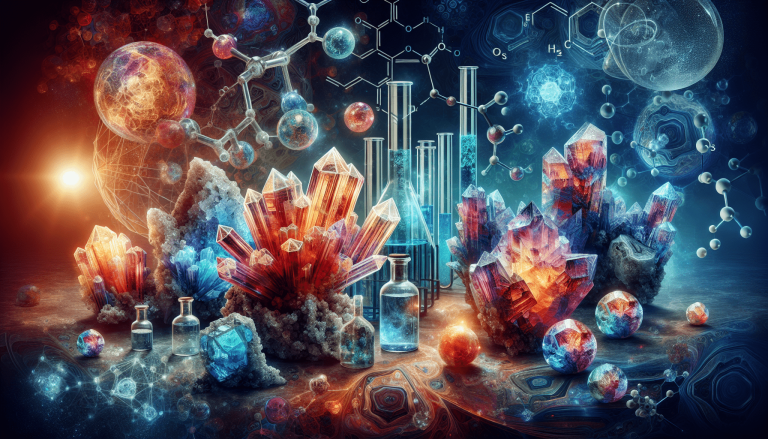Factors That Influence The Chemical Properties Of Minerals
So you’re curious about what factors play a role in influencing the chemical properties of minerals? Well, you’ve come to the right place! In this article, we’ll be exploring the various elements that can impact the composition and behavior of minerals. From the internal atomic structure to external environmental conditions, you’ll gain a comprehensive understanding of how these factors shape the chemical properties of minerals. So grab your lab coat and let’s get started!
Composition and Structure
Minerals are naturally occurring substances with a specific chemical composition and crystal structure. Understanding the composition and structure of minerals is crucial to unraveling their chemical properties and behavior.
Chemical Composition
The chemical composition of minerals refers to the elements present and their respective proportions in a mineral. This composition determines the mineral’s identity and many of its key properties. For instance, the composition of quartz (SiO2) gives it its hardness, resistance to weathering, and unique optical properties. Different minerals can have varying compositions, resulting in a vast array of minerals with distinct characteristics.
Crystal Structure
The crystal structure of a mineral describes the arrangement of atoms within its lattice. It is characterized by repeating patterns in three dimensions, creating a crystalline geometric structure. The crystal structure influences several properties of a mineral, including its cleavage, hardness, and optical behavior. The arrangement of atoms in a crystal lattice can vary, giving rise to different crystal systems, such as cubic, tetragonal, and orthorhombic. Each crystal system has its unique symmetry and physical properties.
Atomic Arrangement
The atomic arrangement within minerals has a significant influence on their chemical properties. This arrangement determines the bonding patterns between atoms, which ultimately affects the mineral’s physical and chemical behavior.
Atomic Packing Factor
The atomic packing factor refers to how efficiently the atoms are arranged in a crystal lattice. It is a measure of the space occupied by atoms in relation to the total volume of the lattice. The packing factor influences the density and stability of minerals. For example, minerals with a higher atomic packing factor tend to have higher densities and greater resistance to compression or deformation.
Arrangement of Ionic Bonds
Ionic bonds occur when there is a transfer of electrons between atoms, resulting in the formation of positively and negatively charged ions. In minerals, such as halite (NaCl) or calcite (CaCO3), the arrangement of ionic bonds contributes to their distinctive properties. The strong electrostatic attraction between oppositely charged ions gives rise to high melting points and brittleness.
Arrangement of Covalent Bonds
Covalent bonds involve a sharing of electrons between atoms, creating a strong bond. Minerals like diamond (composed of carbon atoms) have a densely packed arrangement of covalent bonds, leading to their exceptional hardness and high thermal conductivity. The arrangement of covalent bonds within a mineral determines its resilience and resistance to chemical reactions.

Impurities
Impurities in minerals can significantly alter their chemical properties and behavior. These impurities can occur through the inclusion of foreign elements or the substitution of atoms within the crystal structure of a mineral.
Inclusion of Foreign Elements
Sometimes, minerals may contain foreign elements that are not part of their typical chemical composition. These impurities can result from environmental factors or geologic processes during the formation of the mineral. For example, the presence of iron impurities in quartz crystals can give rise to a range of colors, such as amethyst or citrine.
Substitution of Atoms
Substitution refers to the replacement of atoms within the crystal lattice of a mineral with different atoms of similar size and charge. This substitution can occur during the growth of the mineral and can lead to significant changes in its chemical properties. For instance, the substitution of aluminum for silicon in feldspar minerals affects their hardness and resistance to weathering.
Temperature and Pressure
Both temperature and pressure have a profound impact on the chemical properties of minerals. They can influence the stability, phase transitions, and reactivity of minerals under different geological conditions.

Electronegativity
Electronegativity is a measure of an atom’s ability to attract and form chemical bonds with electrons. The electronegativity of elements within a mineral affects its bonding behavior and reactivity. For example, minerals with elements of high electronegativity, like oxygen or fluorine, tend to have greater polarity and can exhibit strong intermolecular forces.
Oxidation State
The oxidation state of an element refers to the charge that an atom has in a compound or mineral. It plays a crucial role in determining the mineral’s reactivity and its ability to participate in chemical reactions. Different oxidation states can result in varying chemical behaviors, including the formation of complexes, redox reactions, and dissolution processes.
Molecular Forces
Molecular forces play a vital role in determining the physical properties and behavior of minerals. Two essential molecular forces encountered in minerals are van der Waals forces and hydrogen bonding.
Van der Waals Forces
Van der Waals forces are weak intermolecular forces that arise due to temporary fluctuations in electron distribution within molecules or ions. These forces play a significant role in minerals composed of non-polar molecules or atoms, such as graphite. Van der Waals forces contribute to properties like cleavage, lubrication, and adsorption behavior.
Hydrogen Bonding
Hydrogen bonding occurs when a hydrogen atom is bonded to a highly electronegative atom (e.g., oxygen or nitrogen) and forms an electrostatic interaction with another electronegative atom nearby. Minerals containing hydrogen bonding, like water (H2O) or various silicates, exhibit unique physical and chemical properties. Hydrogen bonding affects properties such as boiling point, solubility, and viscosity.
Hydration
Hydration refers to the process of a mineral absorbing water molecules into its crystal structure. The inclusion of water can significantly affect the chemical properties of minerals. Hydration can lead to changes in crystal structure, reactivity, and physical properties, such as color or hardness.
Isomorphism
Isomorphism refers to the phenomenon where different minerals with a similar crystal structure can share a common crystal lattice. Isomorphic minerals have similar atomic arrangements but may differ in their chemical compositions. This similarity in structure influences their behavior and physical properties, allowing them to form solid solutions and demonstrate similar patterns of cleavage, density, and optical properties.
Impacts of Light and Radiation
Minerals can exhibit various reactions when exposed to light or radiation. These reactions can significantly influence a mineral’s chemical properties and behavior under different environmental conditions.
Photochemical Reactions
Photochemical reactions occur when a mineral undergoes a chemical change upon exposure to light. For example, certain minerals, like silver halides, darken when exposed to light due to the formation of metallic silver. Photochemical reactions can impact the color, reactivity, and stability of minerals.
Thermal Decomposition
Thermal decomposition refers to the breakdown of a mineral due to exposure to high temperatures. Minerals may release gases, change their crystal structure, or undergo chemical reactions when heated. Thermal decomposition can alter mineral stability, reactivity, and physical appearance. It is often used to extract metals from ores or to transform minerals into more useful forms.
In conclusion, various factors influence the chemical properties of minerals, including their composition, crystal structure, atomic arrangement, impurities, temperature, pressure, electronegativity, oxidation state, molecular forces, hydration, isomorphism, and light/radiation exposure. Understanding these influences is essential to comprehending the unique characteristics and behaviors showcased by different minerals.







